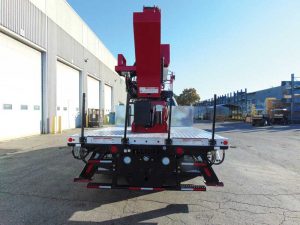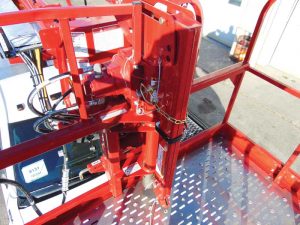
Stabilizers come down from the truck on an angle, occupying minimal space and ensuring installers have the proper footing to complete the job safely.
Some of the new trucks also have self-levelling stabilizers, which automatically go down and steady themselves. This helps increase productivity, as well as ensures the boom is properly level, to decrease the risk of it accidentally tipping over. Once all the legs are down, the installer has 100 per cent stability in every direction. Without automatically stabilizing legs, it can be hard to tell if the truck is stable or if it’s levelled. Automation helps reduce that risk.
Further, depending on the sign company, they can have three different trucks with one person in each truck—which can help increase productivity and work orders if more installers are going out to different sites.
SMC: For companies looking to invest in boom trucks for sign installation, what factors should be considered to ensure the selected equipment meets the safety requirements and operational needs of their projects?
NI: First, in terms of safety, they will want to make sure the boom has a big enough basket. Some sign trucks have smaller baskets—about 1,016 x 1,016 mm (40 x 40 in.)—which are very squared, with very tight space. There’s not much room to move around, or even for the sign to be brought up or placed. Having an extra 508 mm (20 in.) of space makes all the difference, in terms of having equipment that’s right for them and their projects. They also need to have a good business model to ensure once they have the truck, it’s working for them and not always sitting around.
SMC: What new features or innovations are being offered on boom trucks for sign installation, and how can businesses prepare to adopt these advancements while maintaining a strong focus on safety?
NI: The self-levelling stabilizers are one of the newer features being offered on certain boom trucks. Another feature that’s in development and is already being used on some sign trucks—which more manufacturers are also trying to add to their models—is self-unfolding and folding. Essentially, when the boom is folded on the truck, there’s a button you can press to have it automatically unfold and lower down to the ground for you to get in. The opposite can be done when an installer is up in the air. You can press a button and the boom will automatically fold back in to where it needs to be, ready to go to the next jobsite.
SMC: Is there anything else you would like to add regarding the benefits of using boom trucks on sign installation sites, or what today’s available safety features can bring to each sign project?
NI: Using a boom truck is incredibly beneficial because it saves so much time. Instead of having to pull different pieces of equipment with a trailer, this sign truck is an all-in-one solution. You can just hop in the truck, drive it to the site, put the stabilizers down, and go up in the basket to install the sign. For safety, having a larger basket makes a huge difference, along with the ability to auto-level the boom, as you’re always going to be stable. Additionally, having a truck with the auto-fold and auto-unfold feature is a big help, because when you’re up in the air, it mitigates the risk of accidentally teetering the boom. When it unfolds, it automatically goes into a slow mode, so it goes down to where you should be, and reduces the risk of shaking the boom too much or falling out of the basket.






